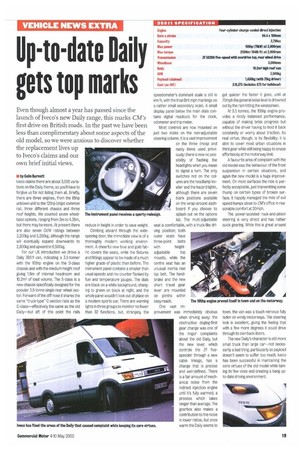Up-to-date Daily gets top marks
Page 21

If you've noticed an error in this article please click here to report it so we can fix it.
Even though almost a year has passed since the launch of Iveco's new Daily range, this marks CM's first drive on British roads. In the past we have been less than complimentary about some aspects of the old model, so we were anxious to discover whether the replacement lives up to Iveco's claims and our own brief initial views.
• by Colin Barnett
lveco claims there are about 3,000 variations on the Daily theme, so you'll have to forgive us for not listing them all. Briefly, there are three engines, from the 85hp unblown unit to the 125hp Unljet common rail, three different chassis and three roof heights. We counted seven wheelbase options, ranging from 3m to 4.35m, but there may be more. At present there are also seven GVW ratings between 3,200kg and 5,200kg, although the range will eventually expand downwards to 2,800kg and upward to 6,500kg.
For our UK introduction we drove a Daily 35S11 van, indicating a 3.5-tonner with the 105hp engine on the S-class chassis and with the medium-height roof giving 1.9m of internal headroom and 10.2m3 of load volume. The S-class is a new chassis specifically designed for the popular 3.5-tonne single rear wheel sector. Forward of the diff nose it shares the same "truck-type" C-section rails as the C-class—effectively the same as the old Daily—but aft of this point the rails
reduce in height in order to save weight.
Climbing aboard through the wideopening door, the immediate view is of a thoroughly modern working environment. A cheerful new blue and gold fabric covers the seats, while the fixtures and fittings appear to be made of a much higher grade of plastic than before. The instrument panel contains a smaller than usual speedo and rev counter flanked by fuel and temperature gauges. The dials are black on a white background, changing to green on black at night, and the whole panel wouldn't look out of place on a modern sports car. There are warning lights in three groups to monitor no fewer than 32 functions, but, strangely, the
speedometer's dominant scale is still in km/h, with the true Brit mph markings on a rather small secondary scale. A small display panel below the main dials contains digital readouts for the clock, odometer and trip meter.
Most controls are now mounted on just two stalks on the non-adjustable steering column. It is a vast improvement on the three cheap and nasty items used previously: there is now no possibility of flashing the headlights when you mean to signal a turn. The only switches not on the column are the headlamp leveller and the hazard lights, although there are seven blank positions available on the wrap-around dashboard if you choose to splash out on the options list. The multi-adjustable seat is comfortable, with a truck-like driving position; both outer seats have
three-point belts
with height
adjustable top
mounts, while the centre seat has an unusual inertia reel lap belt. The handbrake and the new short travel gear lever are mounted on plinths within easy reach.
One vast im
provement was immediately obvious when driving away: the obstructive dogleg-first gear change was one of the major complaints about the old Daily, but the new lever, which controls the ZF fivespeeder through a new cable linkage, has a change that is precise and well-defined. There is a fair amount of mechanical noise from the indirect injection engine until it's fully warmed, a process which takes longer than average. The gearbox also makes a contribution to the noise in lower ratios, but once warm the Daily seems to get quieter the faster it goes, until at 70mph the general noise level is drowned out by the rain hitting the windscreen.
At 3.5 tonnes, the 1135hp engine provides a nicely balanced performance, capable of making brisk progress but without the driver having to hold it back constantly or worry about traction. Its real virtue, though, is its flexibility: it is able to cover most urban situations in third gear while still being happy to cruise effortlessly at the motorway limit.
A favourite area of complaint with the old model was the behaviour of the front suspension in certain situations, and again the new model is a huge improvement. On most surfaces the ride is perfectly acceptable, just transmitting some thump on certain types of broken surface. It happily managed the mile of evil speed humps close to CM'S office in reasonable comfort at 20mph.
The power-assisted rack-and-pinion steering is very direct and has rather quick gearing. While this is great around
town, the van was a touch nervous fully laden on windy motorways. The steering lock is excellent, giving the feeling that with a few more degrees it could drive through its own back doors.
The new Daily's character is still more small truck than large car--not necessarily a bad thing, particularly as payload doesn't seem to suffer too much. lveco has been successful in maintaining the core virtues of the old model while taming its few vices and creating a bang upto-date driving environment.




































































































